In the desert, kangaroos primarily eat a variety of plant-based foods, including grasses, herbs, shrubs, and succulent plants.
These plant species have adaptations to survive in arid conditions and provide the necessary nutrients and moisture for kangaroos to thrive in the harsh desert environment.
Kangaroos have evolved specialized digestive systems and gut microbes that allow them to efficiently break down and extract nutrients from the tough fibers of desert plants.
They also have adaptations to conserve water, obtaining moisture from the plants they consume and tolerating long periods without direct access to drinking water.
Kangaroos, renowned marsupials of Australia, have evolved remarkable adaptations to overcome the challenges of finding food in these arid regions.
This article delves into the fascinating world of kangaroo diet in desert environments, exploring the unique strategies and adaptations that enable them to survive and thrive.
The Challenges of Finding Food in Arid Regions
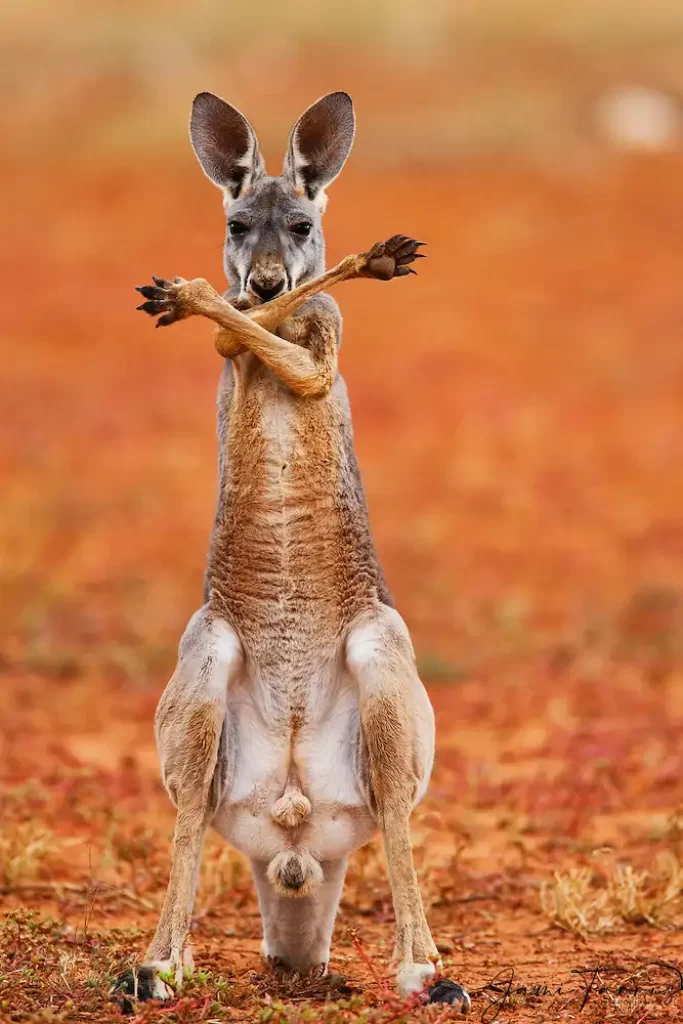
Deserts pose significant challenges for herbivorous animals like kangaroos. The scarcity of rainfall limits plant growth, resulting in limited food availability.
Moreover, the extreme temperatures and aridity of these environments can cause dehydration and further impact the availability of suitable vegetation. Kangaroos must navigate these hurdles to ensure their survival and meet their nutritional needs.
Adaptations of Kangaroos
To cope with the challenges of finding food in the desert, kangaroos have developed remarkable adaptations that allow them to thrive in these arid environments.
Efficient Water Utilization
Kangaroos possess an exceptional ability to conserve water. Their kidneys are highly efficient at concentrating urine, minimizing water loss. Additionally, kangaroos can obtain a significant portion of their water requirements from the moisture present in the plants they consume, reducing their dependence on external water sources.
Specialized Digestive System
Kangaroos have a unique digestive system that aids in the breakdown and utilization of plant material. They possess a complex foregut fermentation chamber, known as the “sacciform forestomach.”
This chamber houses specialized bacteria and microorganisms that assist in the breakdown of tough fibers found in desert vegetation, allowing kangaroos to extract maximum nutrition from their food.
Selective Feeding
Kangaroos exhibit selective feeding behavior, targeting specific plant species that offer higher nutritional value and are better adapted to arid conditions. They have the ability to distinguish between different plant types, favoring those with higher water content, lower fiber content, and richer nutrient profiles.
Mobility and Foraging Strategies: Kangaroos are highly mobile and possess remarkable agility, allowing them to traverse vast distances in search of food. They have the ability to cover extensive ranges to locate areas with better vegetation availability. Furthermore, kangaroos employ feeding strategies such as “grazing” and “browsing” to optimize their foraging efficiency and exploit different food resources.
Desert Vegetation and Adaptations
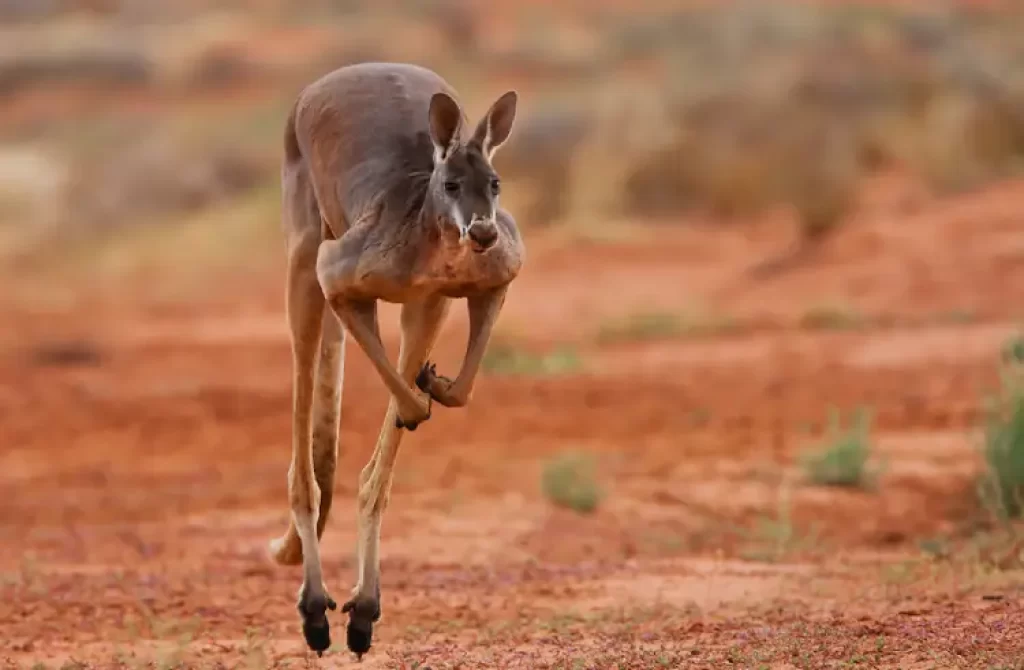
Deserts are characterized by extreme temperatures, limited water availability, and low soil fertility. Despite these harsh conditions, certain plant species have evolved remarkable adaptations to thrive in these arid environments.
These plants are often drought-tolerant, capable of conserving water, and have specialized mechanisms for acquiring and storing moisture.
Some of the unique plant species found in desert regions include cacti, succulents, and various shrubs. Cacti, such as the prickly pear and barrel cactus, have thick, fleshy stems that store water, enabling them to survive for long periods without rainfall.
Succulents, like the agave and aloe vera, have thick, waxy leaves that help retain moisture and minimize water loss through transpiration. These adaptations allow them to endure the intense heat and aridity of the desert.
Kangaroos and Desert Plants
Kangaroos have also adapted to feed on the specific vegetation found in desert regions. While they are primarily herbivorous, their diet varies depending on the available plant species.
In desert environments, kangaroos mainly consume grasses, low-growing shrubs, and leafy vegetation. They have a selective feeding behavior, preferring certain plant species over others.
The specific adaptations of kangaroos enable them to efficiently extract nutrition from the desert plants they consume.
Kangaroos have complex digestive systems that are well-suited for processing plant material. They possess a large, specialized chamber in their stomach called the foregut, which contains bacteria and microbes responsible for breaking down cellulose and extracting nutrients from the tough plant matter.
Importance of Water Content
Water availability is a critical factor for kangaroos living in the desert. While desert plants may have lower water content compared to those in more humid environments, they still provide a valuable water source for kangaroos.
Certain desert plants, such as succulents, have high water content stored within their tissues. When kangaroos feed on these plants, they not only obtain vital nutrients but also fulfill a portion of their hydration needs.
However, kangaroos have also evolved remarkable physiological adaptations to minimize water loss and maximize water conservation. They have highly efficient kidneys that concentrate urine and reduce water loss.
Additionally, kangaroos can enter a state of torpor during periods of extreme heat or drought, lowering their metabolic rate to conserve energy and water.
You might find interesting: What Do Kangaroos Eat?
Kangaroo Dietary Preferences:
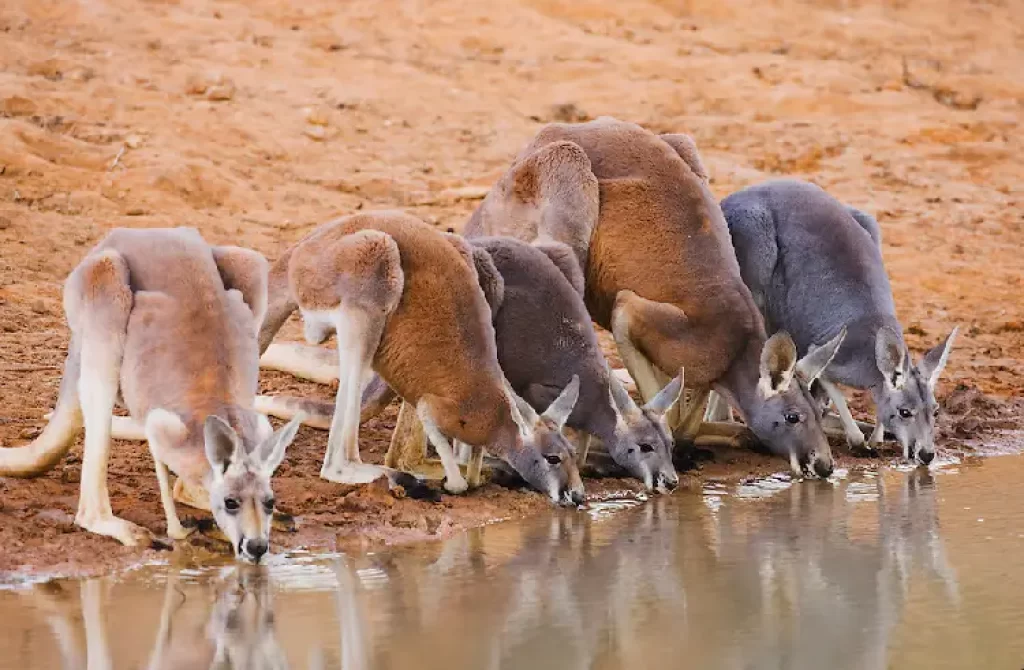
Grasses, Herbs, and Shrubs
Grasses play a vital role in the diet of kangaroos in the desert. They consume a variety of grass species, such as Mitchell grass, bluegrass, and spinifex.
These grasses are low-growing and well-adapted to the arid conditions of the desert. They provide essential nutrients, including carbohydrates and proteins, which are crucial for the kangaroos’ energy and muscle development.
In addition to grasses, kangaroos also feed on a range of herbs and shrubs. These plant species, such as saltbush, mulga, and quandong, offer a diverse array of nutrients and minerals.
Herbs provide kangaroos with additional vitamins and antioxidants, contributing to their overall health and well-being.
Shrubs, on the other hand, often have deep root systems that allow them to tap into underground water sources, making them an important food source during dry periods.
Succulent Plants
Succulent plants, like the iconic prickly pear cactus and various agave species, are another significant food source for kangaroos in the desert. These plants have adapted to store water within their fleshy leaves and stems, making them a valuable resource in arid environments.
The high water content of succulent plants not only aids in the kangaroos’ hydration but also provides essential electrolytes to maintain their physiological balance.
Nutritional Value and Availability
The primary food sources of kangaroos in the desert offer a well-balanced nutritional profile. Grasses, herbs, shrubs, and succulent plants provide carbohydrates, proteins, vitamins, and minerals necessary for the kangaroos’ growth and survival. These plants are often rich in fiber, which plays a crucial role in their digestion.
However, the availability of these food sources can fluctuate depending on the aridity of the desert environment and seasonal variations. Kangaroos have adapted to the unpredictable nature of their habitats by being selective feeders and having the ability to switch between different food sources based on availability.
Importance of High-Fiber Diets
High-fiber diets are essential for kangaroos’ digestion, particularly in the desert where water availability is limited. The fibrous plant material stimulates gut movement and promotes the growth of specialized gut microbes that assist in breaking down cellulose. This process allows kangaroos to extract maximum nutrition from the tough and fibrous plant matter they consume.
Moreover, the high fiber content in their diet aids in water absorption and retention. The fibers act as a sponge, absorbing moisture and facilitating its utilization within the kangaroo’s body. This adaptation helps kangaroos conserve water, allowing them to thrive in arid environments where water resources are scarce.
Digestive System Adaptations
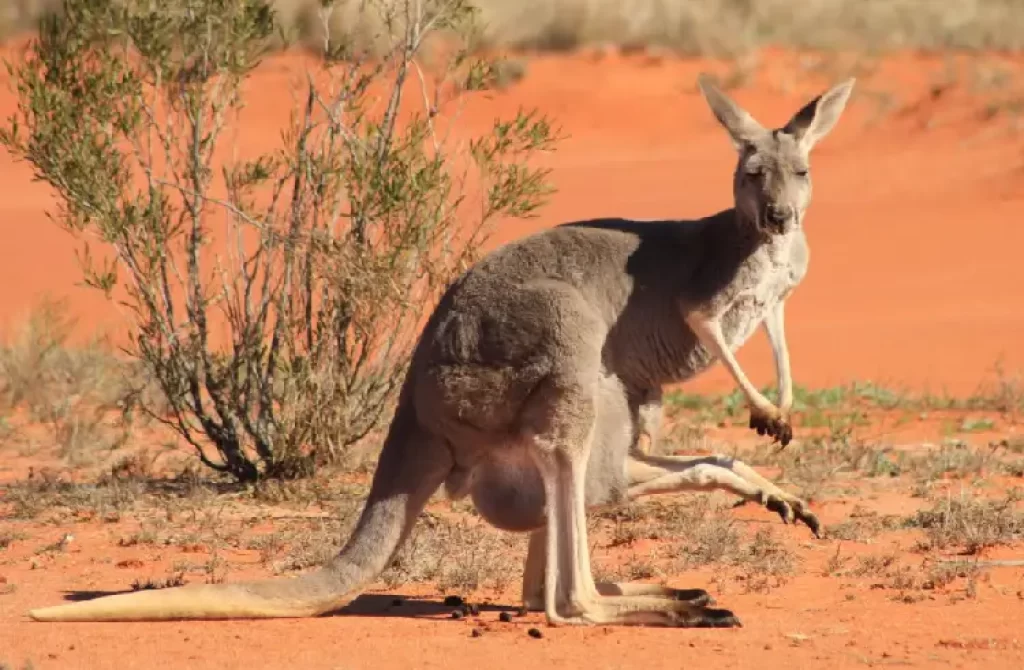
Kangaroos possess a unique digestive system that has evolved to efficiently process the tough and fibrous plant material found in their desert diet.
At the heart of their digestive system is the foregut fermentation chamber, commonly known as the “sacciform forestomach.” This specialized chamber plays a crucial role in the kangaroo’s ability to ferment plant material and extract nutrients from cellulose-rich desert plants.
The sacciform forestomach is a large, muscular compartment located just after the kangaroo’s esophagus. It serves as a fermentation vat where plant material undergoes a complex process of microbial digestion.
Within this chamber, kangaroos house a diverse community of gut microbes, including bacteria, protozoa, and fungi.
These microbes play a vital role in breaking down the tough fibers present in the plant material, as kangaroos lack the enzymes necessary to digest cellulose on their own.
The process begins when kangaroos consume plant material such as grasses, herbs, and shrubs. Once ingested, the food enters the sacciform forestomach, where it is mixed with saliva and microbial populations.
The microbes present in the chamber produce enzymes capable of breaking down cellulose, a complex carbohydrate found in the cell walls of plants.
As the plant material is fermented, the microbes release enzymes that degrade cellulose into simpler sugars, such as glucose.
These sugars are then absorbed by both the kangaroo and the gut microbes themselves. This symbiotic relationship allows the kangaroo to extract valuable nutrients from the plant material that would otherwise be indigestible.
The breakdown of tough fibers in the sacciform forestomach produces volatile fatty acids (VFAs) as a byproduct.
These VFAs serve as a significant energy source for kangaroos, supplying them with the necessary fuel to survive in the arid desert environment. Additionally, the gut microbes themselves contribute to the kangaroo’s nutrition by synthesizing essential vitamins and other nutrients.
The role of gut microbes in the kangaroo’s digestive process highlights the importance of maintaining a healthy microbial population within the sacciform forestomach.
Factors such as diet changes and stress can disrupt the balance of these microbial communities, affecting the kangaroo’s ability to efficiently digest plant material.
Therefore, maintaining a stable and diverse microbial population is crucial for the kangaroo’s overall health and well-being.
Adapting to Arid Environments: Kangaroos’ Remarkable Water Conservation

In the harsh and arid desert environments where kangaroos reside, water is a scarce resource. To cope with limited access to drinking water, kangaroos have evolved remarkable adaptations that allow them to conserve and obtain moisture from their diet and tolerate long periods without direct water intake.
One of the key water-saving adaptations of kangaroos is their ability to obtain moisture from the plants they consume.
Desert plants, such as grasses, herbs, and succulent shrubs, often contain a significant amount of water. Kangaroos have developed specialized physiological mechanisms to extract and utilize this moisture efficiently.
When kangaroos consume plant material, their digestive system plays a crucial role in water conservation. As mentioned earlier, kangaroos have a foregut fermentation chamber, the sacciform forestomach, where plant material is fermented by gut microbes.
During the fermentation process, water is released as a byproduct. Kangaroos can reabsorb this water from their digestive system, allowing them to maximize their water utilization and minimize water loss.
Furthermore, kangaroos have the ability to concentrate their urine, reducing the amount of water expelled from their bodies.
This concentrated urine helps conserve water by retaining valuable fluids within their system. Additionally, kangaroos exhibit efficient water reabsorption in their kidneys, enabling them to retain as much water as possible.
Kangaroos are also highly efficient in their overall water usage. They have a lower metabolic rate compared to many other mammals, which helps them conserve water by reducing the amount of water needed for metabolic processes.
Additionally, kangaroos can tolerate long periods without direct access to drinking water. They have the ability to adjust their metabolic rate and enter a state of “metabolic water conservation” during times of water scarcity.
This means they can minimize water loss through respiration and other physiological processes, allowing them to endure prolonged periods without drinking water.
Water conservation is of paramount importance in desert environments, where water sources are scarce and unpredictable.
The ability of kangaroos to obtain moisture from their diet and tolerate long periods without direct water intake is crucial for their survival.
The efficient utilization of water resources ensures that kangaroos can thrive in arid habitats where other animals may struggle to survive.
Kangaroo Diet in the Desert: Adapting to Arid Environments
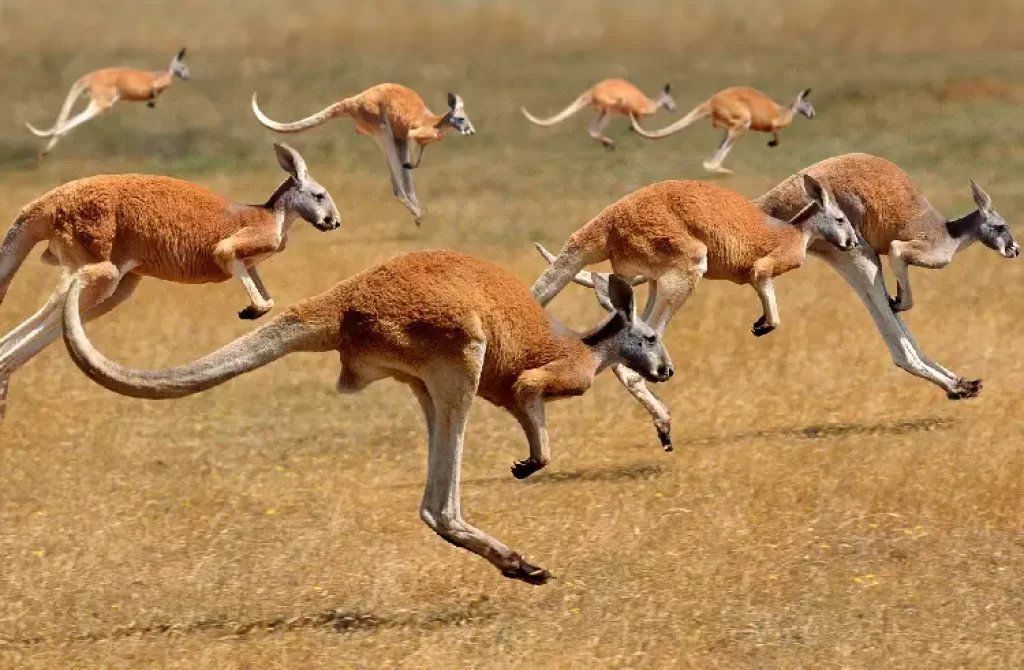
It’s important to note that the specific plant species consumed by kangaroos in the desert can vary across different regions.
The availability of vegetation is influenced by factors such as soil type, rainfall patterns, and temperature variations, resulting in diverse plant communities in different desert environments.
As a result, kangaroos adapt their feeding habits based on the available vegetation in their particular desert habitat.
In some desert regions, grasses play a significant role in the kangaroo’s diet. These grasses often have adaptations to withstand arid conditions, such as deep root systems to access groundwater or the ability to quickly regrow after rainfall.
Kangaroos will graze on these grasses, utilizing their efficient digestive system to extract nutrients and moisture.
In other desert areas, herbaceous plants and succulent shrubs become important food sources for kangaroos.
These plants have unique adaptations that enable them to store water in their tissues, allowing them to survive in the arid environment. Kangaroos will browse on these plants, taking advantage of their water content and nutritional value.
Furthermore, some desert regions may have a higher abundance of shrubs and low-growing vegetation compared to grasses. In these areas, kangaroos will adapt their feeding habits to primarily consume these shrubs, which provide them with essential nutrients and water.
Kangaroos have the remarkable ability to adjust their diet according to the available vegetation in their specific desert environment. They can selectively target plants that provide the necessary nutrients and hydration they require to thrive.
This adaptability ensures their survival in diverse desert habitats and allows them to make the most of the resources available to them.
You might also like
- What do Kangaroos Look like When They are Born?
- How do Kangaroos Communicate With each Other?
- Are Kangaroos Dangerous?
- Human vs Kangaroo: Who Wins the Ultimate Fight?
- How Many Kangaroos are there in Australia?
- What do Kangaroos Eat in the Desert?
- Can Kangaroos Move Their Legs Independently?
- Kangaroos Can’t Walk Backwards: Myth or Fact?
Conclusion
Cangaroos have remarkable adaptations that allow them to thrive in the harsh and arid conditions of desert environments.
Their ability to obtain moisture from the plants they consume, along with their water-conserving physiological mechanisms, enables them to cope with limited access to drinking water.
By consuming plant material with a high water content, kangaroos extract and utilize moisture efficiently, maximizing their water utilization and minimizing water loss.
They have evolved specialized digestive systems and gut microbes that aid in breaking down tough fibers and extracting nutrients from cellulose-rich desert plants.
Kangaroos are highly efficient in their water usage, exhibiting concentrated urine and efficient water reabsorption, as well as the ability to adjust their metabolic rate during periods of water scarcity. These adaptations allow them to tolerate long periods without direct access to drinking water.







